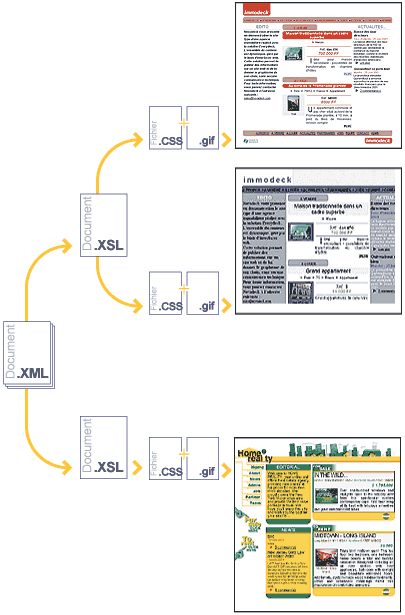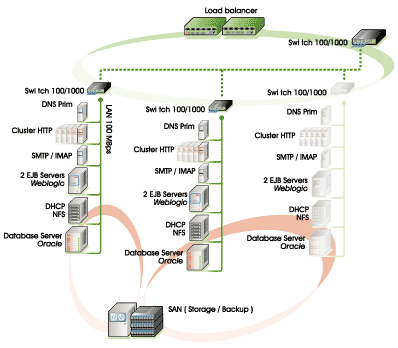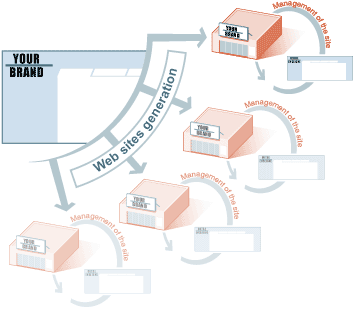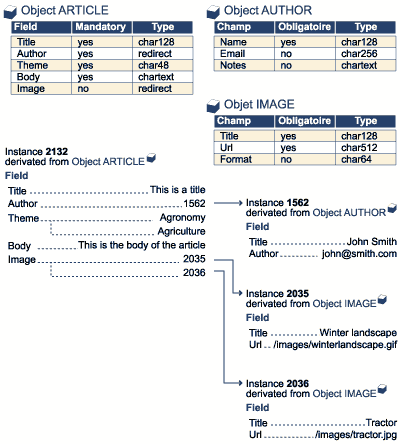| Main features of the platform
Descriptive approach of web sites' conception
The conception of a dynamic web site usually implies a programmatic approach: business processes are implemented in an executable code (PHP, ASP, JS, Servlet...) in order to handle data specific to the web site. Business processes are coded by specialized engineers in order to enable the management of content (data recovering, data updating, data formatting, etc.). The integration & design team then associated them to a layout.Web site conception as proposed by Novadeck puts an end to this programmatic approach by using a descriptive approach of the needs.
Once the data's structures that will be handled (through a simplified interface for business object's creation) have been defined, handling methods are immediately available and cover all sorts of needs: content linked to each object can be displayed, formatted, published or de-published, moderated, searched, updated or deleted through universal interfaces which are not programmed.
The conception of each content page follows this descriptive approach. It is limited to the description of types of data for each page, possibly under specific conditions, and integrated in a structuring XML framework. Lastly, the resulting XML content is adapted to the display terminal (web browser, wap, etc.) by applying a standard XSL stylesheet, which enables various layouts of a unique content.
| Such an approach features unquestionable advantages: much shorter development time, lower technical level for site's creators, and interfaces' standardization. |
|
 |
 |
| XSL style sheets' use to change the publication of a unique XML content |
 |
 |
 |
Multi-sites platform
A unique Novadeck's platform is able to handle a high number of various web sites, each of these sites having its own data's structures, its own design and navigation tree, its own domain name and naturally its own content.
Nonetheless, it is possible to share both data and structures among the sites (for instance to publish a common content on all sites), or to apply the same presentation to various sites. Similarly, all the sites on the platform can share the same users' base: a user can have different rights on different sites and a single sign on system can ease the navigation between these various sites by keeping the visitor's identity from one site to the next, even if they are not hosted under the same sub-domain name.
| Visitors' tracking is common for the entire platform, which enables consolidated cross-sites statistics. |
|
 |
 |
| Redundant, fault tolerant cluster architecture of the Novadeck platform |
 |
 |
 |
Sites generation from a template
The descriptive nature of a web site's creation on a Novadeck's platform and its intrinsic multi-sites nature make it possible to generate independent web sites on the basis of one site template.
The process is fairly easy: a web site model is created just like any independent web site. The content management's engine derivates from it a template that will be applied to create a new web site: perfect clones, though totally independent from each other, can be created anytime. This enables to create a sites' network based on one single template. According to the features of the template, derived sites may share or not some common attributes (as for instance their graphical design or part of their content). This enables an harmonious and controlled life cycle of the sites.
| This unique and original feature, directly resulting from Novadeck's technology's specificities, enables solutions so far too heavy to implement. It also gives the possibility to deploy in no time pre-formatted web sites answering specific, identified needs. |
|
 |
 |
| Dynamic web sites' generation from a template |
 |
 |
 |
Details of the functionalities
Data's structures
In order to structure content manageable on a web site, Novadeck has developed a flexible object oriented model, administered through a simplified web interface. Each data's object (typical basic structure such as an article, an employee, a product in a catalog) is composed of fields which define the object.
Each field can be mandatory (in this case, no object can be published if fields are not filled in) or not. Each field is characterized (numeric or alphanumeric, limited or unlimited number of characters or not, date, etc.). By principle, each field is multiple, which means it can be filled in several times for each instance; the availibity of this functionality is only constrained by the instances of the management's interface. Lastly, a field can be defined as "redirect" i.e. it redirects towards another instance and its associated content, the identifier of the target instance being stocked in the redirect field.
When created, each instance of an object is automatically provided with general attributes such as author, creation date, last modification's author, last modification's date: these attributes do not need to be managed in standard fields and are automatically updated.
| This enables the construction of complex data's structures that answer most of the needs that can be met in advanced content web sites' development. |
|
 |
 |
| Redirections between instances |
 |
 |
 |
Administration rights
The management of every content's object (create, modify, delete) is limited by a very precise administration's rights policy. Each field of an object can have different creation and modification rights (for instance the title of an article can be created by a user having an editor's right, but it can only be modified by users with a moderator's right).
A specific right - owner- secures the fact that only the creator of an instance will be allowed to modify it. Deleting an instance is limited to the modification's rights of the fields of the instance.
| Such a system enables a large flexibility and accuracy in content management. The number of administration's rights is not limited on the platform. |
|
 |
 |
Multilingualism
Each content's structure can be declined in as many languages as needed. Each site has a default language in which each content's element (for publication) must be instantiated. These primary instances can then be completed in one or more additional language(s).
| When the content is retrieved for publication, it is possible to precise the language in which it should be published (for each field of the object). If the field has not been translated in the specified language, content will be published in the primary language. |
|
 |
 |
Content publication
In order to be displayed on a web site, the content instance of an object must be published beforehand in a publication list. Publication lists' role is to distribute the content in the site. For example, instances of a same Article object's type can be posted in two different publication's lists depending on the section (for example Press or References) where it should be published on a web site. The publication lists specify which content must appear on which page.
A single instance can be published on several publication lists (one single content for two different locations on a site). The publication of an instance can be specified for a given time ("publish the article tomorrow at midnight"), and so the de-publication (in order to give an expiration date to non-permanent material). It is also on the publication lists that the moderation process is operated: an instance can be marked as needing the validation of a user with a moderating right to be actually published on the site.
| The publication list is also a tool for information sharing between different sites: by defining a list as "exportable", one allows its use from a site different from the one where it has been created and administrated. Thus, a portal web site can easily share its news with another site of its commercial network. |
|
 |
 |
Summary of the features of the Novadeck platform
| Content management |
 |
 |
Multi display publication (HTML, WML...) |
 |
 |
 |
moderation |
 |
 |
 |
multilingualism |
 |
 |
 |
files' upload and download |
 |
 |
| Administration rights: 5 levels |
 |
 |
root |
 |
 |
 |
administrator |
 |
 |
 |
moderator |
 |
 |
 |
editor |
 |
 |
 |
user |
 |
 |
| Visitors' statistics |
 |
 |
basic analysis |
 |
 |
 |
personalized analysis (complementary tool) |
 |
 |
| Search engine |
 |
 |
all data is stocked in the database |
 |
 |
 |
uploaded documents are indexed (complementary tool) |
 |
 |
| Domain names' hosting |
 |
| Email |
 |
 |
webmail |
 |
 |
 |
alias |
 |
 |
 |
mailing |
 |
 |
References
Novadeck Content Management System 1.0 has been chosen by the Aventis Foundation for its institutional web site and its collaborative portal Science Generation.
|
